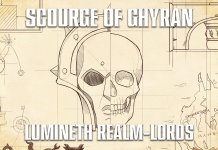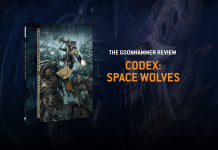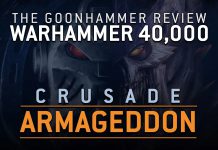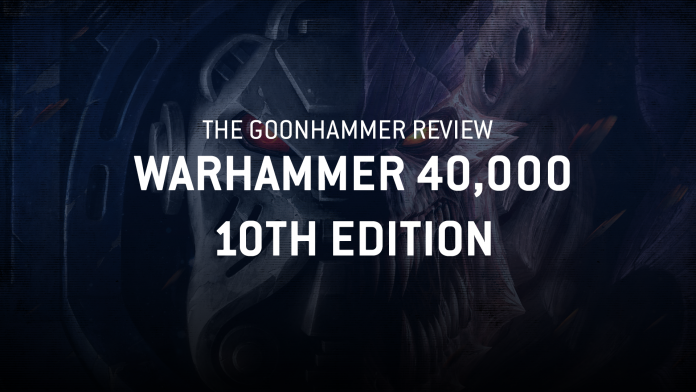You’ve been waiting for months, and it’s finally here: the tenth Edition of 40k. Promising a simplified (but not necessary simple) rules framework, more clarity than ever, and a complete overhaul of unit rules, this new edition is poised to be the best one yet, taking everything learned over the last three years of 9th edition and giving us the tightest rules yet.
In this multi-part series we’re going to go through the game rules, how 10th edition is played, and offer our thoughts on the good and bad of that plus some tactical insight every step of the way. There’s a ton to cover here so we’re breaking it up into more manageable chunks to make it easier to read and browse. For quick navigation, you can use the links below (links will be added as articles are published):
- Part 1: The Core Rules
- Part 2: Playing the Game
- Part 3: The Leviathan Box
- Part 4: The Leviathan Mission Pack (This Article)
- Part Bonus: Leviathan Datasheets
- Part 5: Crusade
- Part 6: Our Thoughts – A Roundtable
- Part 7: Combat Patrol
In this article we’re going to give the overview of 10th edition – the good, the bad, and what you need to know in a nutshell – and we’ll talk about changes to the core rules and the way players muster armies.
As always, thanks to Games Workshop for providing a preview copy for purposes of this review.
Warhammer 40,000’s tenth edition is on its way and one of the biggest changes the game makes is to its mission structure: Gone are the Open/Matched/Competitive mission modes of the past, replaced with a single missions pack for Leviathan. In this article we’ll dive into the Leviathan Mission pack, talk about what it is, how it works, and how to make the most of it during your games.
What is the Leviathan Mission Pack?
The Leviathan Mission Pack sets out the structure for how you play games of 40K. It acts as a sort of hybrid of a Chapter Approved Mission Pack and Tempest of War from 9th Edition 40k. Physically, it’s a deck of cards that comes in your Leviathan box, within which is everything you need for a two player game.
What’s in the Mission Pack?
- A booklet outlining how to play a Leviathan game.
- A set of six objective markers.
- One set of five deployment zone cards (also outlining objective maps).
- One set of nine Primary Mission cards.
- One set of twelve Mission Rule cards.
- Two sets of Secondary Mission cards.
- Two sets of Gambit cards.
Using a combination of all of these materials, you can either design or randomly generate a mission for two players. The cards themselves are fairly sturdy and tarot card sized, same as Tempest of War from the previous edition. How do you use them?
Creating a Mission

To build a mission, you need the Deployment Zone cards, the Primary Mission cards and the Mission Rule cards. All you actually need to do with these is shuffle each deck up and draw one of each. This will provide you with a deployment map, showing where each player can set up their armies and where to place the objectives, a Primary Mission, outlining what players need to do in order to score up to 50 Primary Mission Victory Points, and a Mission Rule, providing a twist or special rule that adds some new dimensions to the game. Once that’s done, you follow through the game sequence outlined in the booklet to prepare for battle and play out the game.
You do not, obviously, have to do this randomly, and our expectation is that for tournament play we’re going to see organizers pick combinations designed to give engaging, balanced missions. Games Workshop are going to be publishing a GT mission pack PDF that provides some advice and suggested combinations, which we expect will be pretty widely adopted. Let’s dig into each of the building blocks here.
Deployment Maps
The five deployment maps available are going to be pretty familiar to long-term players. You’ve got classics Dawn of War (players deploy on the long edges), Hammer and Anvil (short edges) and Search and Destroy (rectangular corners), plus two diagonal deployment zones – Sweeping Engagement (where players set up along the long edge, but within a zone defined by a line is drawn from the middle of the left short edge to the far corner of the long edge) and Crucible of Battle (similar, but for the short edge). The two “straight” deployment zones are structured so that armies will be at least 24” apart, but the others add a bit of variety on distance – Search and Destroy lets you start pretty close if you’re really going for it, as each player’s zone starts 9” from the centre, Sweeping Engagement starts you a bit closer than 24” together, and Crucible slightly more.

Each map has five objectives on it – one in the centre, one in each deployment zone, and two more that are along the mid-line between the two deployment zones. You may be wondering why the box contains six objectives, given that, and we’ll see why when we get to Mission Rules.
There’s nothing too surprising about these maps – there’s a fair bit less variety than there was in the 9th Edition ones, as they all follow a pretty similar template, but for veterans this is all stuff we’ve seen before. It also means that being able to fight for the mid board is going to be very important in Leviathan – there aren’t any maps like Tide of Conviction and Recover the Relics from 9th Edition where you could draw defensive lines just outside your deployment zone if the matchup called for it, so bear that in mind while building your army lists.
A final important point here is that no one will ever have to measure out the map for Data Scry Salvage ever again. RIP to the worst mission map, 2020-2023. May we never see its like again.
Key Changes
- Five deployment maps, each with five objectives.
- All have a home objective each, a centre objective and two other no-man’s land objectives.
Primary Missions
Once you’ve got the mission map, you need a Primary Mission to determine how to use those objectives to score points. Each player can score up to 50VP from the Primary Mission, making it the biggest chunk of points available, so very important.
Here there’s a lot more variety than in 9th Edition, though there are some options that import elements of it. Take and Hold is probably the simplest mission in the deck, giving each player 5VP (to a maximum of 15VP) for each objective they hold in their Command Phase in the 2nd-5th Battle Rounds, with the player going second getting to score at the end of their final turn instead of in the Command Phase. Familiar stuff, and reliably pretty high-scoring – you can max this by holding two objectives for two turns and three for two turns. There’s then a simple spin on this in Priority Targets, which caps the per-turn scoring at 10VP each, and then awards up to 15VP for holding objectives at the end of the battle (the player going second scores in their Command Phase as normal, so they don’t double dip on this!). This one demands some aggressive play from the player going first, as it’s very easy for the player going second to max their score if they’re still on the battlefield in numbers at the end of the game.
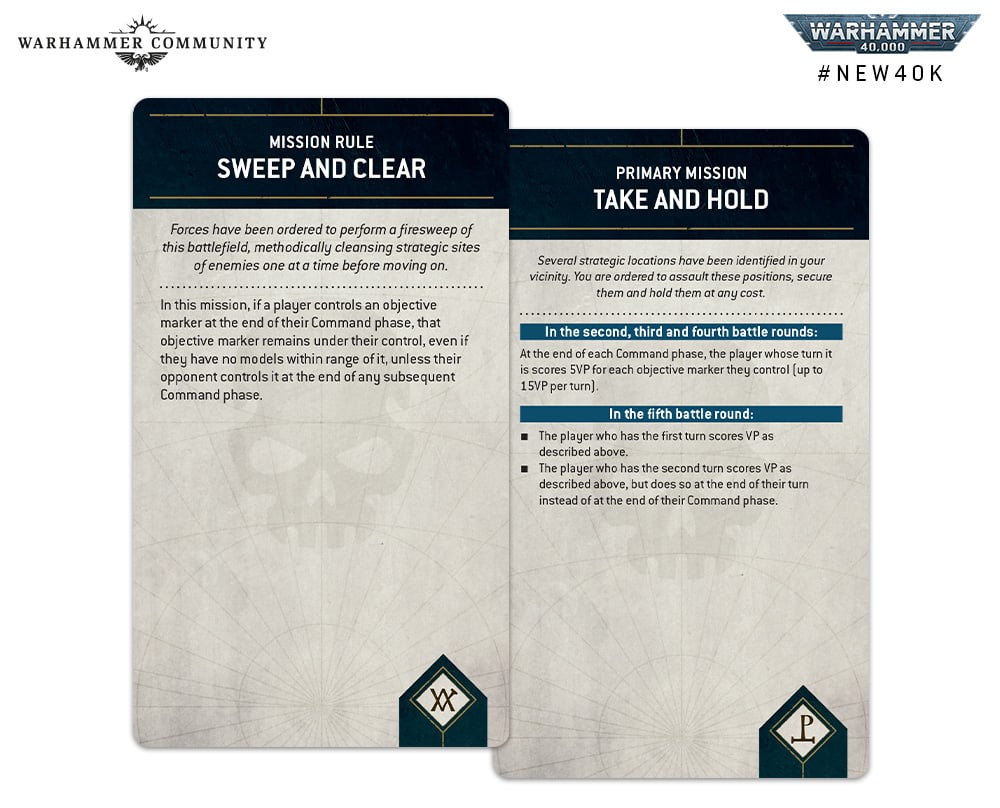
We’ve then got four missions that still run off the basics of “hold objectives”, but each add twists to the formula, or skew scoring based on where objectives are held. Vital Ground removes the centre objective, and rewards you with higher scores for holding no-man’s land objectives or the one in your opponent’s deployment zone, Scorched Earth lets you burn and remove objectives in no-man’s land or the opponent’s Deployment Zone (and rewards you for doing so), Supply Drop only lets you score points from the no-man’s land objectives, and removes two of them over the fourth and fifth turns, giving you a massive bounty for holding the remaining one on the final turn, and Sites of Power rewards you for claiming a no-man’s land objective with a Character and keeping them there, continuing to rewards you with points as long as they hold their position, even if the opponent takes control of the objective.
The three remaining ones all mix things up a bit. Purge the Foe should be familiar to players used to the Nova or ITC missions from 8th Edition – in your command phase you get 4VP for holding an objective or 8VP if you hold more than the opponent, and each battle round you get 4VP for destroying an enemy unit or 8VP if you destroyed more than your opponent did. Classic bloodbath stuff. The Ritual scores similarly to Take and Hold, though only from no-man’s land objectives, but adds a wild twist to objective placement. In this, the two non-central no-man’s land objectives get removed from the board, and each turn a player can generate an additional objective marker that’s within no-man’s land and exactly 9” away from an existing one by sacrificing the opportunity to shoot with one of their units. This is something completely new, and we’re pretty excited to try it out.
Finally, the wackiest of the bunch is Deploy Servo Skulls, objective marker tennis. Here, you don’t score points for holding objectives – instead, at the end of each turn, players can each move any of the three objectives that started the game in no-man’s land, and that they control, up to 6”. You score points at the end of your turn based on how close these are to the enemy’s deployment zone, getting a particularly big reward if you manage to push it wholly within their zone. We’ve given this one a go, and it can be pretty hilarious, though it does favour the player going first quite a bit – although you can’t score points in the first battle round, just getting first touch on controlling the objective position is very powerful, particularly as you can grab them, actually move them slightly towards your side of the table, making it hard for the opponent to get to them, then at the end of your opponent’s turn and your subsequent turn, aim to shift them a full 12” opponent-ward. Obviously Infiltrators or Scouts can aim to meddle with this, but we’re interested to see if this plays out as a problem (though it’s fair to say that some of the other missions look like they give a hefty boost to the second player).
There’s definitely enough interesting choices here to create a mission pack with some variety, and they tend to do a better job than 9th of forcing aggressive play. There is an interesting facet that quite a few of these don’t really reward you for holding your home objective, so although some Secondary Missions can still incentivise that, you may sometimes see faster armies making the choice to pivot entirely away from their home positions. Having something that can tank in a mid-field position is also going to be very important, so expect to see players rifling through their indexes looking for the toughest stuff on the market.
Key Changes
- Far wider variety of Primary Scoring methods.
- Some very similar to 9th Edition, with minor variations.
- Some much more unusual, including an ITC 8th Edition-like and several that move/manipulate Objectives.
Mission Rules
The last part of generating a mission is to choose one of twelve Mission Rules. This is something that we’ve seen a fair bit of apprehension about from competitive players, as it sounds a bit like Open War twists from previous editions, which could often create very imbalanced games, or add a special rule that’s not particularly fun to adjudicate.
The good news here is that there’s a fairly decent balance in this deck. There are some things that add some random elements that competitive play will probably eschew (things like Mortal Wounds on a high Advance roll from Minefields and a random chance of reserves failing to arrive on turn two from Delayed Reserves), but there’s also some options that are just straight from mission-specific rules in 9th Edition like “sticky objectives” from Sweep and Clear and Vox Static (no Infiltrators/Scouts in no-man’s land, not something we love but a rule that’s featured in competitive packs before). We also expect to see Hidden Supplies used quite a bit in competitive play – this removes the centre objective and adds two in its place, each 6” towards a corner of the battlefield in opposite directions, creating a six objective map that adds some variety. Supply Lines is also a “positive” version of the same rule from 9th, giving you a CP on a 4+ if you control your home objective in your command phase.
Moving onwards to new ground, there’s a few cards that interact with the Tempest-style Tactical Objective Secondaries, either providing additional card draws or letting you have more active objectives at once, or in one case making the New Orders stratagem that lets you replace one cost additional CP, along with Command Re-roll. Jury’s out on whether these will see much use – it feels like there’s a decent chance that the positive ones make it too easy to max out Secondaries, and increasing the cost of Command Re-roll is going to cause so many “ah crap, we played this wrong” moments that we’re not sure it belongs in a tournament, but these absolutely are interesting things to draw up in a pickup game.
The three remaining cards after all this provide one that lets you opt out of this entirely, one that lets you go full chaos mode by drawing multiple cards, and finally one that makes the objectives player-placed, just like in the old Maelstrom pack. This is another one that’s fun for a pickup game, but probably shouldn’t go in tournament packs – there is some curation of how placement works, so it’s not as easy to entirely ruin yourself in objective placement, but historically player-placed objectives are the kind of mechanic that has a neutral impact on the game if both players know what they’re doing (or both don’t), but brutally punishes a skill mismatch, which isn’t great for a mechanic that’s only occasionally relevant.
Overall, these do feel like they provide some useful building blocks for competitive missions, and should all be fine if drawn randomly in casual play. It feels like the balance could maybe have been skewed one further towards rules that feel designed for tournaments, probably replacing one of the two variants on “more cards” – as it is, we suspect that there will be some re-use of the most streamlined ones.
Key Changes
- A number of Mission Rules that replicate elements from 9th Edition like sticky objectives.
- Others that add 8th Edition Maelstrom-like Secondary Twists.
- Some that add more Open War-style random elements.
Secondary Missions
Your Primary Mission is worth up to 50VP, but there’s another 40VP to be had by completing Secondary Missions, achieved using the Secondary Mission cards. There are two identical sets of these, one for each player, containing 16 cards apiece. Each Secondary outlines a goal for the player to try and achieve, and a victory point award that they receive if they do so, often scaling based on how well they do. An example of this is the Behind Enemy Lines Secondary. This awards you with 2VP if you get one unit into your Opponent’s deployment zone at the end of the turn, or 4VP if you get two in.

Seven of the Secondaries also have a symbol allowing them to be selected as Fixed Secondary Objectives. What are those? Well, one of the big innovations in the Leviathan deck is that it combines elements of both Tempest of War and Grand Tournament Secondaries from the previous edition. At the start of the game, you secretly select whether you are playing with Fixed or Tactical Secondaries. You do this by selecting two cards from the deck and placing them face down – either two with the Fixed Secondary symbol, or two without it. Both player then reveal these – if they reveal Fixed Secondaries, those become their Secondary Objectives for the whole game, and they can score them repeatedly, to a maximum of 20VP for each. If non-fixed Secondaries are revealed, then the player shuffles them back into their deck, and plays with Tactical Secondaries.
When using Tactical Secondaries, you draw until you have a hand of two at the start of each of your turns, and when you achieve one you discard it. You have access to the New Orders Stratagem that lets you discard and then draw a card at the end of your Command Phase once per battle, and at the end of your turn you have the option of cashing in one of your remaining cards for a Command Point, a good way to get rid of something that’s not currently possible. Once a card is discarded, either by being achieved or for a Command Point, it’s gone for good – there’s no mechanic allowing you to recur a card a second time if you’re playing with Tactical Objectives.
The Secondaries available fall into three broad categories – control specific objectives (sometimes your home one, sometimes the opponent’s home one, and a few twists like a no-man’s land objective selected by your opponent), killing stuff (sometimes specific types of thing like Vehicles) or getting a unit to a certain position then performing an activity instead of shooting. Most award you 4-5VP on success (with many 5VP ones having a 3VP “consolation prize” version), with a few outliers in each direction, so you’re generally going to need to achieve somewhere between 8-10 in a game to score maximum points. This is a high enough target that you pretty much do need to go hard for every Secondary available to you when playing Tactical – you can probably afford to discard one over the course of the game and still hit max points, but as soon as you discard the second it becomes a tall order.
Why go random at all then? A concern that’s been floating around since these mechanics were previewed is that players would just always choose Fixed Secondaries, but some thought has clearly been put into incentivising this, using two main methods. First up, Secondaries are simply better when playing Tactical – most options that can be picked as fixed Secondaries reward an extra VP if they’re drawn as a Tactical one (including the Behind Enemy Lines example above, which changes to 3/5VP when Tactical), reflecting the fact that an army may not be built for them. Maxing your score with Fixed Secondaries is actively hard – most of them cap at 4VP a turn in Fixed mode, so you have to score them perfectly to get maximum points. That is sometimes going to be possible, particularly if your opponent has enough Characters that you can score maximum points on Assassinate, but it’s rarely going to be trivial. There probably are going to be armies that can be built to try and force the issue on the combo of Behind Enemy Lines and Deploy Teleport Homers, but going that route will give the opponent a very clear goal for disruption, and probably one where they can happily score Tactical Objectives at the same time.
The other incentive is access to extra CP when you really need it – players don’t start with any CP in Leviathan, so are only working off the one from the start of each turn and any additional they can generate. There are some game-changing Stratagems like Heroic Intervention that cost you 2CP, so being able to guarantee a second CP at a key moment can be quite potent, and as above you can probably get away with doing this once and still have a realistic shot at a maximum score, particularly if you use that command point to enable a big score on Storm Enemy Stronghold, claiming the enemy’s home objective for 8VP.
It definitely seems plausible that both options will see use. If you’ve build an all-rounder army, you’re probably going for Tactical objectives unless your opponent’s list is very vulnerable to Assassinate or Bring it Down, but as Competitive Players get their hands on this we probably will see dedicated armies built, particularly because there’s no restrictions on which of the Fixed Secondaries you can take together, so synergistic pairings are a possibility. There’s probably some risk of this ending up the optimal way to play, but our current vibe is that the balance feels about right between the options, and that many players will end up going Tactical a lot of the time. Not an easy balance to strike, and we’re very encouraged by the level of thought that’s clearly gone into this!
Key Changes
- You can choose between two fixed Secondaries or Tempest-style Tactical Objectives every game.
- If you pick fixed Secondaries, you can score a maximum of 20VP for each.
- If you pick tactical Secondaries, you are rewarded with higher scores on lots of the cards, and a chance to gain CP by discarding one.
Gambits
The final scoring mechanic in Leviathan is Gambits, which offer an alternative Primary scoring method. At the end of Battle Round 3, each player gets a chance to switch out their Primary Mission for a Gambit. They keep any Primary VP scored so far, but can no longer gain any more, instead receiving a 30VP bonanza at the end of their final turn if they complete their Gambit. Each Gambit deck contains four cards – three Gambits that have a chance of coming up, and one Proceed As Planned card. At the end of the third Battle Round, each player puts their Proceed as Planned card aside, then shuffles the remaining three cards and discards one at random. They then secretly select between the three cards they have remaining – either choosing Proceed as Planned to stick to the normal method of Primary Scoring, or selecting one of the two available gambits for a chance at a big points swing.
Chance is the key thing here – in all cases, there are dice rolls involved to determine whether your gambit works, and while you can increase your chance of pulling them off, success will never be certain, and often still unlikely even with a well-executed plan. In addition, the things they ask of you are often going to be difficult in any game where the opponent is shutting you out of the Primary, as they involve your units being alive and being in the right position. The three options require you to either get units into one or more battlefield corners to boost your chance of an orbital strike, get the vast majority of your remaining forces into the battlefield centre, or tag the majority of enemy units in Engagement Range, optionally also Battle-shocking them to increase your chances. These are tricky things to do if you’re short on stuff!
Discarding one each game also means you can’t plan around any individual one being available every time, which stops you playing for pure primary denial with a plan to “force” one of these as an alternative to scoring yourself (which i think would maybe be doable with Delaying Tactics, the one you push the odds highest on, but also the hardest to set up when you’re getting bodied). There are basically two situations you’re going to ever consider these in:
- You went first, scored decently early on, but your opponent has quickly counterattacked you off objectives, and you might just have enough stuff left in your fifth turn to get a chance on these.
- You went second, and are doing OK in terms of board control, but got fully denied on turn two and your opponent has had a good enough Primary and Secondary start that they’re going to come in at near max points.
Those both feel like situations where you should want something like this, and we’d guess you’ll maybe pull it off 10-20% of the time in a game where you make the decision, maybe a bit higher for the second option and Delaying Tactics specifically. In theory this is fine as a concept, as keeping more games exciting for longer is definitely a net good, but we’ll admit we’re not massive fans of how any of the current three cards operate, and we’d like to see some iteration on this concept in the future, perhaps trying things like giving you two “super secondaries” for 15VP each instead.
Key Changes
- Gambits provide an optional alternative Primary scoring option starting from the end of Battle Round 3.
- There are three Gambits, and you’ll get to pick from two each game.
- If you select a Gambit, you can no longer score Primary by normal means, but score 30VP if you complete your gambit at the end of your final turn.
- All Gambits have a dice-roll element, which you can tilt in your favour the better you do at accomplishing the gambit condition.
Mission Process
The last thing to quickly talk about with the Leviathan pack is the mission process. Anyone who’s played a 9th Edition game is going to be familiar with this – it’s a numbered set of steps for setting up a battle, playing it and deciding a victor. Lots of the things we’ve already discussed happen at specific points in this process and don’t need repeating, but there are two key things to highlight here.
First up, the Declare Battle Formations step build on the Declare Reserves and Transports step from the previous edition, both still being the point where you decide which units are being set up in Transports or various forms of Reserves, but also now letting you choose which Leaders join which unit, adding some flexibility (especially if they’ve got Enhancements providing buffs to a unit).
The other is that this is where you find a rule whose absence from the core rules has caused some comment – just like in most 9th Edition missions, when playing a Leviathan game Reserves cannot be set up in the first Battle Round, and must be set up by the end of Battle Round three, or they’re destroyed (excluding anything that enters Strategic Reserves after the battle has begun).
You still get 10VP for having a Battle Ready army too, so everything still adds up to a nice, neat 100VP.
Key Changes
- Leaders getting attached to units happens in the Declare Battle Formations step, which also includes Reserves and Transports.
Final Thoughts
The Leviathan Mission Pack looks like a decent start for the new Edition – the missions are clearly functional, encourage active gameplay, and there’s not too much randomness baked into them, which is good. There are a couple of points of risk that may require some tuning – it looks like maxing out Primary scoring will be a little too easy on some missions, and the overlapping conditions of some fixed secondaries may make it too easy to build a list dedicated to maxing them reliably – but these are both concerns rather than things we’re confident will happen, and we’re very excited to see how the first season of 10th Edition plays out with this pack.

